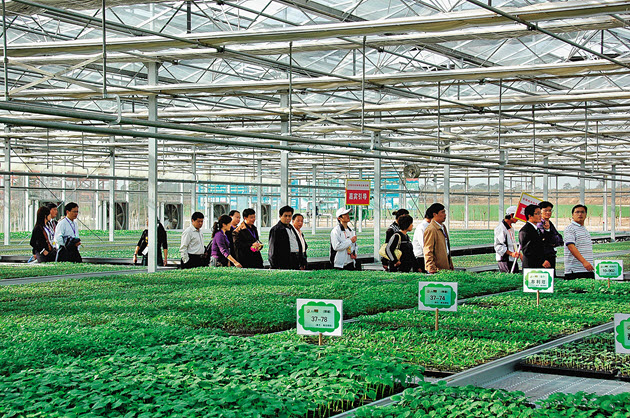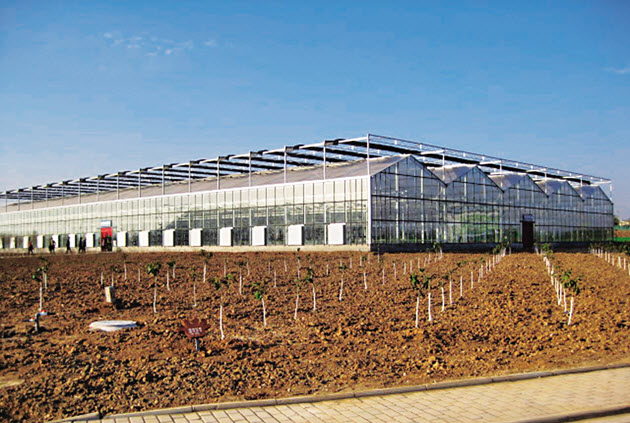A Growing Agricultural Threat
Is Taiwan’s Farm Sector Selling Out to China?

Source:CW
As Taiwanese farmers transplant their operations to China, can the government ensure that the shift represents economic expansion and not the uprooting of the local agricultural sector?
Views
Is Taiwan’s Farm Sector Selling Out to China?
By Sherry LeeFrom CommonWealth Magazine (vol. 454 )
In China’s Fujian Province, one can find a carbon copy of Tea Mountain in Taiwan’s Lugu Township, where even Lugu specialties No. 27 Golden Lily Oolong Tea and jasmine-flavored No. 29 Taiwan Jade Oolong are sold.
The town of Yongfu in southwestern Fujian is located in a mountain basin 800 meters above sea level. In a 1,300-hectare emerald green terraced tea plantation (roughly the area of 1,900 soccer fields), farmers in traditional conical hats cut tea leaves evenly and meticulously with their blades.
Not long before, they had sprinkled fermented soybean milk over the tea bushes to help the leaves grow thicker and more fragrant, and they will soon prepare key tea-processing steps, from fixation (to stop fermentation from heat-induced water loss) to rolling and drying. An “Alishan” tea label will then be affixed to the oolong tea’s container that will be marketed in Beijing, Shanghai and Guangzhou. By producing the tea in China, the plantation’s operator generates a profit margin three times as high as in Taiwan.
But all of the tricks of the trade and production processes used on the Yongfu tea farm come from Taiwan.
Hsieh Tung-ching, the chairman of Tai Pin Tea Inc., which operates the plantation, was the first Taiwanese businessman to establish a presence in Yongfu. In 1996, he flew from Taiwan to Kinmen and then took a ferry to the Chinese coastal city of Xiamen. A two-hour drive later, he was in Yongfu, where over the next 15 years he would build his tea operation into the biggest mountain tea plantation combining Taiwanese and Chinese resources.
Hsieh has noticed that in the past four to five years, tea farmers from well-known tea growing areas in Taiwan, such as Muzha outside of Taipei and Jhushan in Nantou County, have been flocking to China, with over 30 tea growers and a number of award-winning Alishan tea masters having settled there.
Chinese government officials in Yongfu like to exclaim with big smiles on their faces, “Yongfu is China’s Alishan,” referring to the scenic mountain resort in central Taiwan renowned for its mountain tea.
According to Chinese government statistics, 5,700 Taiwanese companies and growers have directly invested in China’s agricultural sector, with countless more indirectly involved in activities related to agriculture or food processing.
In the past two years, Taiwanese agricultural specialists at all levels of expertise and across a broad range of sectors – from tea to flowers to aquaculture – have moved to China, along with agricultural researchers, heads of university agricultural colleges and even a former chairman of Taiwan’s cabinet-level Council of Agriculture (COA).
This phenomenon may be the most high-speed, high-level, large-scale exchange – or exodus, depending on your point of view – of agricultural technicians since links were opened between Taiwan and China in 1989.
Paul M.H. Sun, the 73-year-old former head of the COA, is part of the wave. China’s Ministry of Agriculture hired him on a three-year contract as a general consultant for its “Development Parks for Taiwan Farmers” and invited him to organize a team of Taiwanese experts and consultants.
Sun, who introduced dragon fruit from Vietnam and mango species from the United States to Taiwan when he was young, decided to help Taiwanese farmers expand their market in China. Now, he spends more than half of his time in China shuttling from province to province.
The move across the Taiwan Strait is being fueled by a desire among Taiwanese growers and overseas Taiwanese businessmen to expand their markets and among agricultural experts for a bigger stage on which to perform. But China’s government has also been engaged in a highly strategic gambit to attract Taiwanese farmers.
Helping China Overhaul Its Agricultural System
For many years, the No. 1 priority of Chinese officials has been to solve three intractable agricultural problems: poor agricultural villages, the hard life of farmers, and a lagging agricultural sector. China has long been eager to learn from Taiwan’s agricultural experience to better cope with those issues.

In 1997, China designated Fujian and Hainan among nine experimental cross-strait agricultural cooperation areas. In 2006, following the launch of the Kuomintang-Chinese Communist Party forum, the experiment was moved from the provincial level to China’s State Council, which announced a plan to establish “Development Parks for Taiwan Farmers.”
In fewer than five years, China’s State Council has already approved 26 such “parks” in locations ranging from coastal provinces Fujian, Jiangsu and Shandong, to central provinces Hubei and Hunan, to Yunnan and Sichuan in southwestern China.
Stephen Lu, the director of Yunlin County’s Agriculture Department who was in China recently, believes that Beijing wants to learn from Taiwan to restructure its own agricultural system. The key features of Taiwan’s system it hopes to deduce are an operating model with both cooperatives and smaller product and marketing groups, and widespread cooperation between agricultural research stations and farmers who apply the knowledge in practice. A similar model, however, is already taking shape in parts of China.
Visit any “Development Park for Taiwan Farmers,” and you will be impressed by the production and marketing chain concepts in use that go far beyond traditional crop-growing. A government map of Xincheng Town, Jiaxing City, Zhejiang Province shows a 10,000 hectare (equal to 14,000 soccer fields) Development Park for Taiwan Farmers located in Xiuzhou district.
The park comes complete with dedicated areas for growing organic dates and non-contaminated vegetables, and an agricultural tourism section. It also has an R&D base where improved Taiwanese varieties are being introduced and bred and orchid seedlings are being cultivated.
The delegation from Yunlin visiting China with Stephen Lu came away with one overriding impression, that “Chinese agriculture is undergoing a structural change.”
The word “park” fails to convey the scale of these agricultural areas. They can cover an area equal to half or even an entire Taipei City. Sun says the “parks” have been situated on the peripheries of major cities and concentrate on developing more refined “suburban agriculture.”
The parks are helping prepare China’s agricultural system to graduate from simple crop cultivation to secondary processing and high value-added specialty agriculture.
Yang Xiongnian, the deputy director of the Department of Science, Technology and Education under China’s Ministry of Agriculture, said publicly not long ago that China’s evaluation of model agricultural counties will stress a few key factors, including a precise account of each county’s main products, the crop varieties each is promoting and the technologies involved.
Quickly Learning Tricks of the Trade
The Cross Straits (Yulin) Agricultural Cooperation Pilot Zone in Guangxi, for example, now has 210 crop varieties newly imported from Taiwan. The experimental zone in Hainan, which has a bigger land area, boasts of hosting more than 400 Taiwan-invested agricultural businesses, with more than 2 billion renminbi invested in cultivating seedlings, aquaculture, animal husbandry, and recreational farming. Another park in suburban Shanghai intends to develop a transaction platform for “safe farm products.”

This wholesale transplanting of seedlings, talent, technology and management has helped China rapidly narrow the gap in agricultural development and technology that originally existed between it and Taiwan.
When Li Zidong, the head of the Qingliu County Railway Construction Office in Fujian, came to Taiwan 10 years ago, he was on a recruiting mission, talking to Taiwanese farmers in the Hoklo language – the most common idiom in Taiwan’s countryside – and offering them “land for 2 renminbi a square meter.” A number of farmers took Li up on the offer, bringing their pears and new varieties of cut flowers to Qingliu and improving the agricultural structure of the area that previously concentrated on rice. Today, Qingliu farmers also wrap fruit grown on trees in protective bags and use machinery to fertilize their crops, as is done in Taiwan, and their average per capita income has grown from 1,000 renminbi 10 years ago to 4,000 renminbi today. Li says bluntly: “Taiwanese farmers need to work harder; otherwise, their tricks and skills will have all been learned.”
The technology related to roasting tea that Taiwan has amassed over many years is also quietly being transplanted to China. The Tie Guanyin variety of oolong tea that used to be produced by Chinese farmers yielded a dark red-colored brew, but now their tea produces a brew even greener than that grown by Taiwanese tea farmers. Chinese farmers have mastered crop improvement methods and the use of new production equipment, and can fully control temperature and humidity during the tea roasting process. As Hsieh says, “They learned very fast, and absorbed everything there was to know.”
Does Taiwan Have a Strategy?
The speed at which China has learned not only from Taiwan but also Japan and the Netherlands even had Tainan County Magistrate Su Huan-jhih saying, “Taiwan’s agricultural sector can’t get complacent.”
But Chen Wu-hsiung, the current head of the Council of Agriculture, said in an interview with CommonWealth Magazine that there is little the government can do to block the exodus of Taiwan’s agricultural sector.
“We don’t know how many farmers have gone to China as individuals or in groups,” Chen admits. “Each individual has been there dozens of times, and they don’t need the government’s help to lead them there. The Council of Agriculture is also in no position to take local farmers across the Taiwan Strait to develop.
“Everybody wonders why the government doesn’t put a stop to it. In fact, the agricultural sector is the same as the manufacturing sector. The government has no way of banning the practice,” Chen says with resignation.
In the industrial sector, however, there at least is an objective: Taiwan clearly wants to capitalize on China’s labor and market. But when it comes to agriculture, the administration of President Ma Ying-jeou has only said it would not open Taiwan’s market to imports of 850 agricultural items from China that are currently banned. But his government has rarely mentioned its strategic objectives for Taiwan’s agricultural deployment in China.
That lack of an overall plan has angered former Council of Agriculture chairman Peng Tso-kwei.
“Since 1996 when the government’s ‘no haste, go slow’ policy toward China was announced, Taiwanese farmers have resorted to their own devices to carve out their own niches, but at the same time, China has adopted various methods to get what they want. When the government talks about agricultural interests moving west [i.e., across the Taiwan Strait to China], it’s as if it’s talking about AIDS. But if we don’t let agriculture go there, that’s a dead end,” Peng says. “The result is that China is the big winner. It’s taken Taiwan’s seedlings, technology, and management. It’s taken everything.
“Every day, there are a lot of groups going to China who are unconditionally giving everything away. I want to ask President Ma Ying-jeou what he wants from cross-strait agricultural exchanges,” Peng asks.
The question that still needs to be answered is whether the cross-strait shift of Taiwan’s agricultural sector represents a fundamental uprooting of the sector or an extension of its strength. The government needs to take stock of this phenomenon, which has never been earnestly addressed, and carefully devise a strategy to cope with it.
Translated from the Chinese by Luke Sabatier






